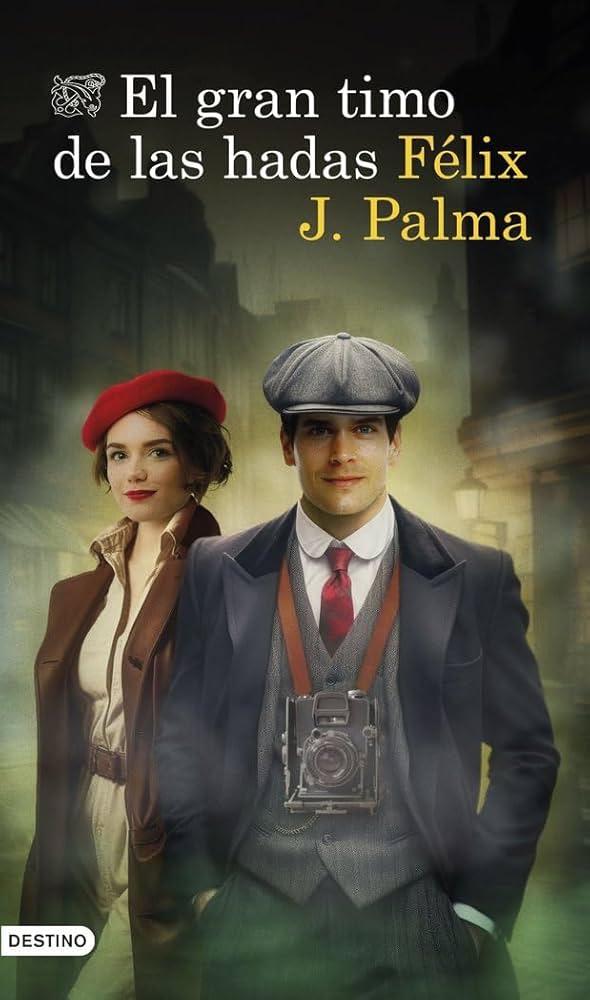In interwar London, a couple of photographers take on a commission that soon turns into a dangerous fable, where reality and fantasy intertwine until they become indistinguishable. A story brimming with magic, mystery, and unexpected twists, masterfully told by bestselling author Félix J. Palma.
In England, 1922, Alan and Violet Schofield run a peculiar photography studio that offers far more than portraits: they create illusions. They design and photograph dolls representing fairies, gnomes, and goblins so convincingly that their clients—mostly grieving people searching for certainty—accept them as real. But their work is not just a business: it is a way to comfort those the world has left behind.
Alan—whose real name is Jimmy—was a small-time con artist who, after a life of scams and a narrow escape from death in the war, stole the identity of a corpse named Alan Schofield. In the hospital, he met Violet, a reserved and brilliant nurse, who decided to play along. Together they traveled to London, pretended to be married, and persuaded Alan’s uncle to give them an old studio and a photography shop, to which they devoted themselves completely.
Their lives change when Joe Pettigrew, a thug and an old acquaintance of Jimmy, shows up to blackmail them into participating in an elaborate con. They must convince Councilman Percival Drake—Pettigrew’s boss, a powerful and suspicious man haunted by the death of his daughter—that fairies have stolen the body of the girl, dead long ago, in order to obtain a magical emerald he owns. Pettigrew wants the emerald, worth a fortune, and believes such a con would raise no suspicion. Alan and Violet manipulate Drake’s environment, stage supernatural appearances, and weave a mythical tale as detailed as it is emotional. The plan begins to work. Drake falls deeper into the trap.
The climax takes place during a supposed ritual at a dolmen. Alan and Violet, with the help of Pettigrew and Fry—an old friend of Alan—had prepared a performance to finally steal the emerald, but something unexpected happens: a golden light emerges from the dolmen and a winged figure appears, followed by a little girl. Even Pettigrew is astonished. Fry, bewildered, hands Drake’s emerald to the fairy. No one knows if what happened was real or just an illusion. Confused and distressed, Drake demands answers. Fry tells him that his daughter has chosen not to return, disappointed by what she has seen of her father from the other side. Struck by this revelation, Drake acknowledges his mistakes, promises to change, and leaves moved, holding onto the hope of seeing her again someday.
However, Pettigrew is not satisfied. The emerald is gone, and he demands his share. When he does not get it, he shoots Alan. All seems lost until Fry kills Pettigrew. Violet then reveals that Alan is alive. Everything had been carefully orchestrated by them with the help of April, Violet’s younger sister, who played the role of the girl in the ritual. Months later, now free from threats, Alan proposes to Violet—this time, for real.
RELEVANT FACTS: Félix J. Palma is a writer, creative writing teacher, and literary coach. His novels have been published in more than twenty-seven countries, reaching over 600,000 readers. He has won numerous awards and appeared on The New York Times bestseller list.
The Great Fairy Scam is a story that blends fantasy and gangsters in a novel brimming with love and magic. It has strong audiovisual potential thanks to its combination of genres: period drama, heist movie, and magical realism, with a visually striking aesthetic. Set in interwar London, the narrative alternates between the intimate and the spectacular: sharp dialogue, touches of humor, and scenes filled with tension and mystery. It is a story that can appeal to a wide audience.
Moreover, its protagonists—Alan/Jimmy and Violet—have a deeply ambiguous relationship that can sustain the dramatic weight of a series or film. Their personal conflicts (identity, guilt, love, and redemption) intertwine with a sophisticated play of masks and manipulations, leading to constant twists that keep the narrative taut. The plot invites exploration of the contrast between the real and the fabricated, in the vein of titles such as The Illusionist or The Prestige.
AUDIOVISUAL POTENTIAL: TV Series, Miniseries, Film, TV Movie.
LANGUAGES AVAILABLE: Spanish.

Adquirir los derechos
Para ponerte en contacto con nosotros completa el siguiente formulario y te responderemos en breve.
Error: Contact form not found.

